Lea Wait's Blog, page 253
August 10, 2016
#WriterWednesday: 20 Questions to Help Write Strong Characters
This month, I thought I would include the Maine Crime Writers in something I’ve just started doing at my own blog on Wednesdays, to celebrate something the Twitter-verse calls #WriterWednesday, or #WW. In the Twitter world, you use that hashtag and then include all the writers in your sphere as a little virtual shout out. Don’t worry: I’m not going to do that. Instead, this #WriterWednesday I thought I would post an excerpt and exercise from my new writing guide, Creating Complex Characters. The guide is broken down into five daily lessons and corresponding exercises that help writers master the fine art of character building. Since I know a fair number of our readers at MCW are writers, it seemed like this might be appreciated.
This excerpt is from day two of the book, titled Getting to Know Your Characters:
 On day one of Creating Complex Characters, I looked at one of the biggest questions out there for fiction writers: What motivates your character? Now, let’s move on to those little details that make a character come to life for readers. Things like personal history, physical characteristics, financial constraints, and spiritual philosophies all come into play here. A lot of what you learn about your character in today’s exercise may never even be mentioned in your novel, but knowing them goes a long way toward informing your narrative. When you know your character inside and out, that knowledge bleeds into things like how they express themselves, how they interact with others, and what their perspective may be in a situation. Not to mention that, if you’re writing a series, knowing the ins and outs of your character up front means you won’t have to second guess yourself in book three when you can’t remember what color your heroine’s eyes are or whether your antihero drives a Camaro or a Prius.
On day one of Creating Complex Characters, I looked at one of the biggest questions out there for fiction writers: What motivates your character? Now, let’s move on to those little details that make a character come to life for readers. Things like personal history, physical characteristics, financial constraints, and spiritual philosophies all come into play here. A lot of what you learn about your character in today’s exercise may never even be mentioned in your novel, but knowing them goes a long way toward informing your narrative. When you know your character inside and out, that knowledge bleeds into things like how they express themselves, how they interact with others, and what their perspective may be in a situation. Not to mention that, if you’re writing a series, knowing the ins and outs of your character up front means you won’t have to second guess yourself in book three when you can’t remember what color your heroine’s eyes are or whether your antihero drives a Camaro or a Prius.
Take Janet Evanovich’s Stephanie Plum as an example of how powerful knowledge of the little things can be for readers. In Evanovich’s bestselling series, bounty hunter Stephanie Plum is a good-old-fashioned Jersey girl with a tight-knit family, a philandering ex-husband, and two sexy-as-sin love interests with their own complicated back stories. What else do readers know about Stephanie?
She has a hamster named Rex, who represents the most enduring commitment she’s made thus far in her life. She has a wildly eccentric grandmother, Grandma Mazur. Her constantly revolving stock of cars is regularly repossessed, crashed, shot at, blown up, or otherwise destroyed, with the exception of Big Blue, Grandma Mazur’s seemingly indestructible 1953 Buick Roadmaster. Fans know how Stephanie’s marriage to Dickie Orr went bad and who he cheated on her with, what Stephanie likes to eat (peanut butter and olive sandwiches and Boston creme donuts), where she grew up, when she was born (October 12), what she wanted to be when she grew up (a reindeer, Peter Pan, Wonder Woman, a rock star, and a rock star’s girlfriend). In other words, Evanovich’s readers know plenty about Stephanie Plum, gleaned over the course of twenty-three books, four novellas, and a short story (as of this writing, anyway). We learned the bulk of that information, however, within the first two to three books—which means Evanovich knew that information within the first two to three books.
If you want to write an enduring series with characters who stay with the reader for the duration, then you need to go into it with a clear idea of those little details. For Evanovich, this might have been fairly simple because of the striking similarities between herself and Plum. In “A Conversation With Janet Evanovich” posted by Claire E. White on the Internet Writing Journal in January of 1999, Evanovich says, “I wouldn’t go so far as to say Stephanie is an autobiographical character, but I will admit to knowing where she lives.” Whether your character is secretly you or not, though, those little details that make us who we are can make or break a book or series.
Writing Exercise: 20 Questions
When I began writing my Erin Solomon mystery All the Blue-Eyed Angels, I was an undergrad at Goddard College. I’d only written literary fiction before that, so the mystery thing was a whole new ball of wax. I found myself getting more and more mired in the plot, and feeling less and less like I understood who my characters were or what role they played in the book. While I felt like I had a pretty good handle on my main character, the motivations of my secondary characters were murky at best. What made them tick? Why were they doing the things I was forcing them to do? What kind of life had they lived before I brought them to the page? In order to get to know those secondary characters better, I embarked on a little mission of discovery for each of them.
That’s what this exercise is about for you.
Begin with a character you don’t know well. This can be one you just thought up, or someone you’ve been writing for a while but with whom you never felt a real connection. And I know you might feel a little silly, but write the answers to the following questions from your character’s point of view.
(1) What was your first car?
(2) Do you believe in God? Why or why not?
(3) Favorite color?
(4) Favorite movie?
(5) Describe your first kiss.
(6) Cat or dog person?
(7) Favorite food?
(8) Famous person you most resemble?
(9) If you weren’t in your current career, what would you be doing?
(10) Where do you want to retire?
(11) Favorite sport? Do you prefer playing or watching?
(12) Which parent are you closer to?
(13) Favorite childhood memory?
(14) Worst childhood memory?
(15) One thing no one knows about you.
(16) Three words friends would use to describe you.
(17) Life of the party or wallflower?
(18) Favorite book?
(19) Who is your hero or heroine?
(20) What is your animal spirit?
When I ran through this exercise with a secondary character who’s kind of a loose cannon in All the Blue-Eyed Angels, Joe Ashmont, I came out with a better idea of where he came from and what vulnerabilities he brought to the table. It made me more empathetic toward the character, and I think ultimately served to make what could otherwise have been kind of a throwaway character, far more complex. Here are a couple of the answers I came up with:
Describe your first kiss.
Out behind the chapel with Becca, on a dare. Second base on that first kiss, at 10 years old. I was what they called an early bloomer. And Becca… Well, she was born good to go.
Cat or dog person?
Dog. The only good cat I ever met was a drowned one.
If you weren’t in your current career, what would you be doing?
Nothing I’d want to do but haul traps. Might as well put me in the ground the day I have to give up my boat.
And that’s the gist of the exercise. If you choose to go through the twenty questions, I’d love it if you would share an answer or two from your character’s point of view in the comments below! Or, let us know if you have other strategies for building memorable characters.
Jen Blood is author of the bestselling Erin Solomon Mysteries and the 5-Day Fiction guide, Creating Complex Characters. To learn more, visit www.jenblood.com.
August 8, 2016
On The Trail Again
There aren’t many entertainment venues up here in the county, but we have those nature has provided. Last month I finally gave in and purchased a Yamaha Wolverine, a side-by-side ATV.in the late twentieth century the railroads serving Aroostook County (the Bangor and Aroostook and the Aroostook Valley Railroad) went out of business. The railroad tracks and ties were removed from all of the B&A and AVR railbeds but the graded bed upon which the tracks were laid was left behind creating a myriad number of ATV/Snowmobile trails.

My Yamaha Wolverine
The former B&A rails pass beside my house and for three years I have watched the ATV and snowmobile traffic that utilizes the trail (appropriately named the B&A Trail) which is maintained by a local ATV/Snowmobile club. The club, out of Caribou, grades the trail to remove potholes, rolls the trail to pack the surface, and removes obstacles such as fallen trees. I recommend carrying a chainsaw if you are capable because it is not unusual to come across a tree that has fallen and is blocking the trail, many of us will remove these obstructions.
The Aroostook trail system is extensive and connects every city and town in the county and a rider can connect with trails further south (I believe that it is possible to travel the length and width of the state on the trail system).
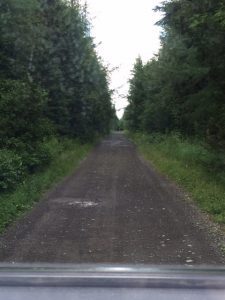 The scenery along the trail is often breathtaking and it is not unusual to encounter wildlife. In the picture to the right two moose stood on the trail and we had to stop and wait for them to wander off into the woods.
The scenery along the trail is often breathtaking and it is not unusual to encounter wildlife. In the picture to the right two moose stood on the trail and we had to stop and wait for them to wander off into the woods.
The trails provide one an opportunity to go into the north Maine woods and lose oneself in nature without worrying about getting lost (the all of the trails ultimately lead to a town) and if you ride on a week day the opportunity to get away by one’s self. As a self-professed hermit I find this to be the best time to ride because for the most part I have the trail to myself. On the other hand if want to see a vast cross-section of humanity to use as characters in your next literary effort the week end will be more to your like. As I said earlier, the B&A trail passes along my property and it is not unusual to count ATVs in the hundreds passing by on Saturday and Sunday.
These summer posts have impressed me with all of the great things there are to do in our state from spending a day in our largest city (Portland) or at one of our quaint coastal towns–but, I’ll take the seclusion of my woods where I get to visit sparsely inhabited lakes and ponds, rivers with crystal clear water, and I can see any number of wildlife species in their natural habitat.
August 6, 2016
Weekend Update: August 6-7, 2016
 Next week at Maine Crime Writers there will be posts by Susan Vaughan (Monday), Vaughn Hardacker (Tuesday), Jen Blood (Wednesday), Kate Flora (Thursday), and Lea Wait (Friday).
Next week at Maine Crime Writers there will be posts by Susan Vaughan (Monday), Vaughn Hardacker (Tuesday), Jen Blood (Wednesday), Kate Flora (Thursday), and Lea Wait (Friday).
In the news department, here’s what’s happening with some of us who blog regularly at Maine Crime Writers:
On Wednesday, August 10th, Kate Flora and Roger Guay will be at the Guilford Library at 6:00 p.m. to talk about riding around in a green pickup truck and writing A Good Man with a Dog. Kate and Roger think they may have found a new way around writer’s block.
And on Thursday, July 11th, Kate and Roger will be at the Center for Moosehead History at 6:00 p.m., to discuss the book.
The Marie Antoinette House … that’s what locals call the house Lea Wait lives in. And on Wednesday, August 10, she’ll be talking about the legends, myths, and realities about that house … and how she’s used its history in her books. Where? The Boothbay Region
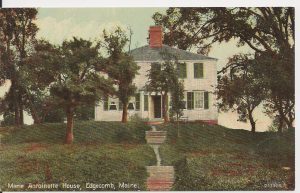
Marie Antoinette House, circa 1890
Garden Club, at St. Columbia’s Church at 32n Emery Lane in Boothbay Harbor. She’ll be speaking at 1:30, and the meeting is open to the public. Her books will also be available for purchase and signing.
An invitation to readers of this blog: Do you have news relating to Maine, Crime, or Writing? We’d love to hear from you. Just comment below to share.
And a reminder: If your library, school, book club, or organization is looking for a speaker, we are often available to talk about the writing process, research, where we get our ideas, and other mysteries of the business. Contact Kate Flora: mailto: kateflora@gmail.com
August 4, 2016
A Day on Monhegan Island
by Barb, writing on her porch while gazing out at Boothbay Harbor
I’ve already done one “Day In” post for Boothbay Harbor where my husband and I spend our summers, but I couldn’t resist doing another. It’s hard to believe that we’ve owned this house for twelve years and been coming here for almost thirty, and yet we’d never been to Monhegan Island. Monhegan sits just twelve miles off the Maine coast, and Boothbay Harbor is one of three places–in addition to New Harbor and Port Clyde–where you can catch the ferry to Monhegan during the summer season.
This year, we resolved to do more touristy things while we’re in Maine. Plus our daughter and her husband visited Monhegan on their honeymoon and told us we were crazy if we didn’t get ourselves out there.
Our day started with a ride on The Balmy Days II out of Boothbay Harbor. The ride takes an hour to an hour and a half depending on conditions, and it’s one of those situations where your vacation starts the moment you step on the boat–not when you arrive at your destination. The crowd on the boat was lively and excited–a group of women celebrating a friend’s birthday, a group of men going fishing, and plenty of couples, families and dogs.

Monhegan from the water
You can go to Monhegan for the day, taking the morning ferry out and the mid-afternoon ferry back, but that only leaves you about three and a half hours on the island, so Bill and I had a reservation to stay overnight at the Island Inn, one of two hotels on the island. (There are also several B&Bs and lots of weekly rental cottages.) As it happened, we made our reservation for two of the most glorious days of the summer. In fact, we’ve been joking that we can never go back, because it will never be that perfect again. Though there are very few vehicles on the island, the hotels and cottages send a pickup truck to schlep your luggage from the dock. Even more wonderful, when we got there at 11:00 our room happened to be ready.

The Island Inn
Lunch: Monhegan has more than twenty artists who will welcome you to their galleries or studios, but only four places to eat. We chose the Fish House Fish Market where you place your order at the counter and sit at picnic tables on Fish Beach. The food was fresh and delicious and the view superb.
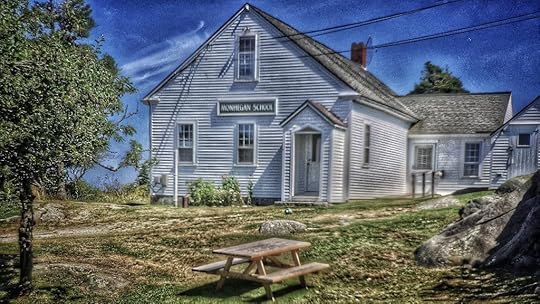
The schoolhouse
Two-thirds of Monhegan is undeveloped due to the efforts of Ted Edison, the son of the inventor, and the Monhegan Associates. In the 1940s and 50s, Edison began buying up land already divided into house lots and now Monhegan Associates’ land encompasses more than 380 mostly wild acres on which they maintain twelve miles of trails. Being humans of the mostly non-hiking variety, we took the easy walk out of town, visiting galleries and shops as we did and then on out to Lobster Cove where Bill explored and photographed the hull of the D.T. Sheridan, shipwrecked off the coast in 1948. While he did that, I sat on the rock promontory, enjoyed the views of the sea, the rocks and the Rockwell Kent-Jamie Wyeth house.
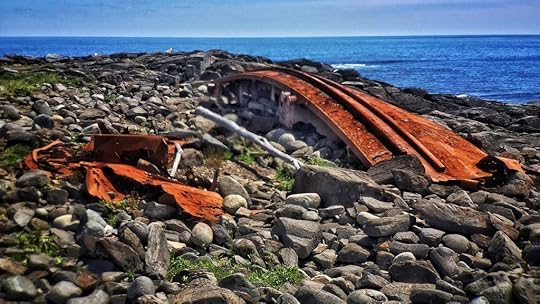
On the way back, treat yourself to a cold one and a seat in the shade at the Monhegan Brewing Company, the island’s micro-brewery. Or have an ice cream cone at The Novelty behind the Monhegan House. Everywhere you look will be a delightful feast for the eye, I promise.
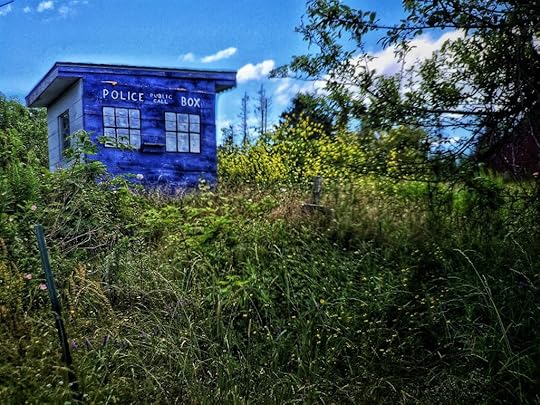
From there we headed back to the Island Inn whose deep front porch and rockers were calling to us. I sat and read a book, looking up to enjoy the views of Manana, the uninhabited island across from Monhegan that forms its protected harbor, as well as the boating activity. We had wine on our room’s little deck, followed by a fabulous dinner at the Island Inn accompanied by a glorious sunset. (You can buy wine on the island, but the liquor laws are convoluted and dinner is BYOB.)
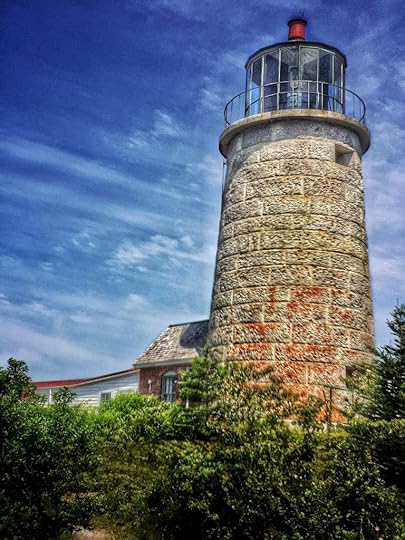
The Lighthouse
Our room at the inn had breakfast included and then we set off again. We walked up to the lighthouse, which has an excellent museum as well as a gallery. Bill continued on across the island to Whitehead while I sat outside, admired the stupendous views, and solved several knotty plot problems.

The view from the lighthouse
Caveats: One thing to keep in mind. Monhegan is actual nature, not a Disney simulation of same. There’s a big sign when you get off the dock warning you that there are no formal emergency services on the island. Many of the trails are challenging, the rocks slippery. Stay above the high water mark, watch for moss, bugs and poison ivy, and don’t go in or near the water anywhere but Swim Beach, since the undertow and currents around the rest of the island mean no one will even try to rescue you if you fall in.

View from Whitehead
After we descended from the lighthouse, we had lunch at the Barnacle on the dock and then took a tour around the island on the Balmy Days II before we headed back to Boothbay.
All together a relaxing, visually stimulating and magnificent day in Maine.
[All photos in this post are by Bill Carito. If you like them and want to see more, you can friend him on Facebook at https://www.facebook.com/bcarito and follow him on Instagram at billcarito and bill.carito.colorphotos.]
Save
Save
Save
Save
Save
Save
Save
August 3, 2016
How did I spend my summer? On the awesome Maine author tour.
How did I spend my summer vacation? Book touring, of course!
Earlier this summer (and are there any sadder words?), my Maine Crime Writer colleague Kate Flora wrote about touring Maine for author events, and all the neat places it brings her.
It was something I’d been thinking about a lot.. The writer’s tour is one of those things — and there are so many — that you never imagine is going to be part of being a published writer until it happens. And when I say the “writer’s tour,” I’m not referring to some planned schedule that the publisher launches you on. I’m sure there are writers in this world who have the benefit of that kind of deal. But most of my Maine crime-writing friends are like me, we fashion our own.
There’s everything from the solo library gig or book store signing to the multi-writer conference, and a lot of things in between. Every one of the events is unique and I have to say I’ve never come away from one that I wasn’t happy to attend. Last year, when I had one book, Cold Hard News, the first in the Bernie O’Dea mystery series, I happily went to events, but also nervously, worried I’d be seen as a one-book wonder. The second in the series, No News is Bad News, came out in July and this year I launched into the touring season with, well, two books.
Regular readers may know that I hurt my arm a couple weeks ago rescuing some orphans and nuns…oh, all right, slipping on a wet bathroom floor. It’s still sore, so I’m going to leave it to mostly photos as to how I spent my summer. So far.
APRIL 28: Belgrade Library author talk
My first solo talk! Knowing that no one wants to listen to be blab on for 30 or more minutes, I put together a slide show to give them a distraction. Technical glitches ensue (I’ve since bought by own projector). Still, my hometown audience was gracious and fun.

The topic was Journalism & Writing. I so have that covered. The Belgrade Public Library audience was enthralled. Or at least too polite to act like they weren’t.
MAY 4: Newport Library author talk
With some of the technical glitches ironed out, I took myself and my slideshow to Newport. I was trepidatious — it was far away territory where no one knew me, and what if no one showed up? I was stunned and amazed at the large, interested audience, many of whom had already read Cold Hard News and had a lot to say about it. Authors, if Newport beckons, go.
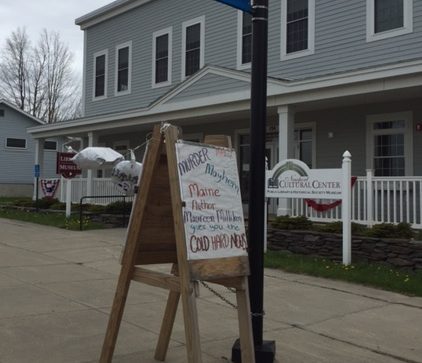
The sign announcing my author talk at the Newport Cultural Center was stolen, so they quickly made a new one that morning.
JUNE 11: Guilford Library Local Authors Fair
A really nice event with a ton of local authors, each with our own niche in the library, food, and so many book lovers attending! It was part of the town’s 200th anniversary celebration, but let’s hope the library makes it an annual event.
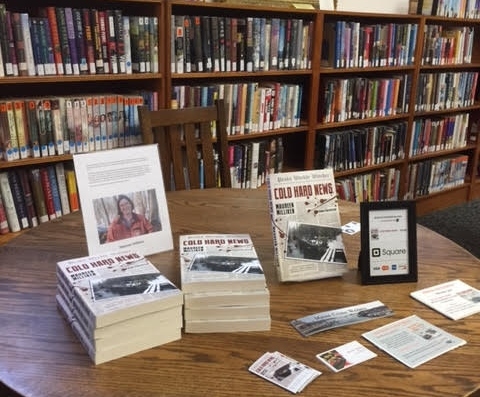
My own nook at the Guilford Library local authors event! This was right before “No News is Bad News” came out, but “Cold Hard News” got a lot of love.
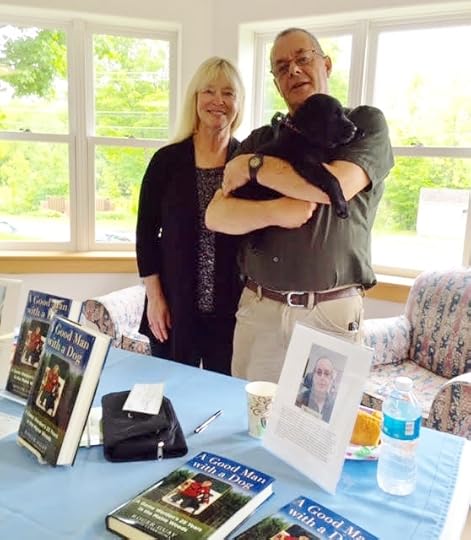
Maine Crime Writer Kate Flora, retired game warden and rookie author Roger Guay, their book “A Good Man with a Dog,” and their secret weapon, Lucy, at the Guilford Library local author event June 11.
JULY 4: Belgrade Lakes Fourth of July
Fellow Crime Writers Flora, Dick Cass (and his wonderful wife, Ann) and Vaughn Hardacker joined me as we greeted the masses that come to the village to eat, enjoy lake views and buy stuff. Including mystery novels, it turns out.
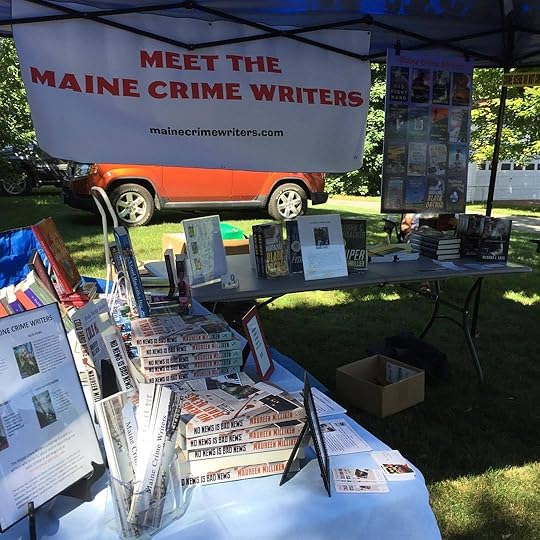
Dick Cass, Vaughn Hardacker and Kate Flora joined me in the Meet the Maine Crime Writers booth at the Belgrade 4th of July extravaganza.
JULY 9: Books in Boothbay
One of Maine’s cooler book events, Books in Boothbay, is sponsored by the Boothbay Harbor Memorial Library and features writers of all genres. We were blessed with a rainy day and a crowd of book-hungry folks. Fellow Maine Crime Writer Jen Blood, also a member of Sisters in Crime New England, added to the fun by setting up a murder mystery for attendees to solve. I was a suspect!

The crowd begins to gather in the Railway Village hall as Books in Boothbay gets underway July 9.
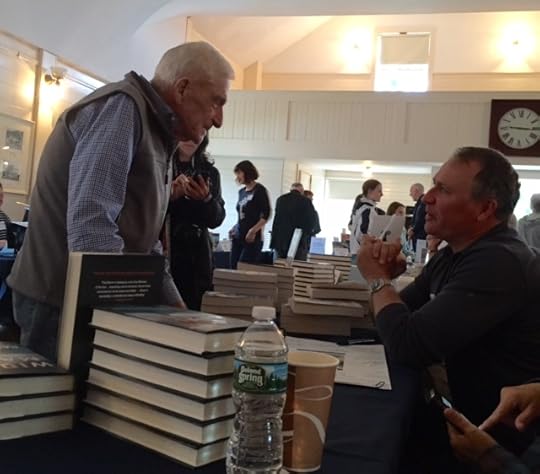
Here’s something you don’t see every day — unless you’re at Books in Boothbay. Donn Fendler of “Lost on a Mountain in Maine” fame talking to fellow crime writer Paul Doiron, who’s latest “Widowmaker” sold like hotcakes. I know because I sat next to him and watched them go.
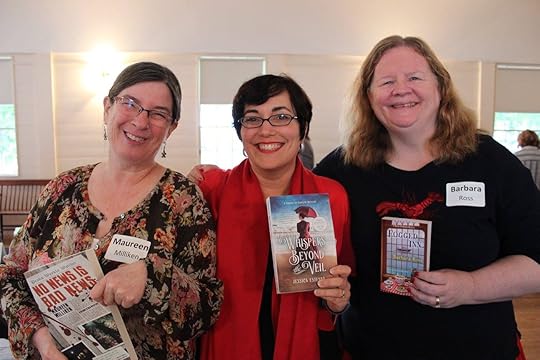
One of the great things about being a Maine writer is hanging with really cool people. At Books in Boothbay, I had Paul Doiron on one side, and fellow crime writers Jessie Crockett and Barb Ross on the other. (Thanks Lynn Plourde for the photo!)
JULY 23: Book signing at The Children’s Book Cellar, Waterville
Book seller Ellen Richmond is a huge supporter of the arts, particularly the literary ones, in Waterville. Her store at 52 Main St. hosts regular signings and I was lucky enough to have one there.

Fortunately I didn’t have to do all the talking at my July 23 signing at The Children’s Book Cellar in Waterville. My dad, left, and Waterville writer and former actor JP Devine kept things lively.
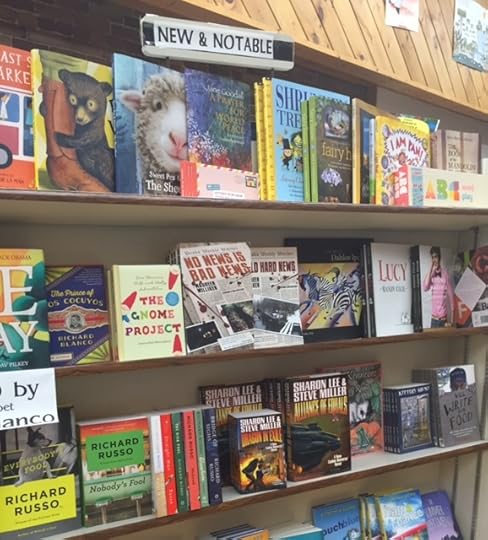
I would have cropped this closer, but man…there’s my books and down in the corner there? My hero Richard Russo. Yup. Almost on the same shelf at The Children’s Book Cellar in Waterville. Don’t worry. I AM humbled.
Summer isn’t over, and truth be told, the writing tour continues wherever and whenever they want me.
AUGUST 10: Author talk, 6-7:30 p.m. at the Maine Lakes Resource Center. It’s free, but you need to RSVP at centralmaine.com/authortalks. Come on and see if my slide show lives up to your expectations. And there are snacks! And, of course, books for sale and signing. I’m also city editor of the Morning Sentinel in Waterville in my secret other life and my employer, Maine Today Media, who is generously sponsoring this event, is sponsoring one with outdoors writer George Smith on Aug. 17, too.
AUGUST 27: Designing Women artists and crafters show, 9 a.m.-4 p.m., Longfellow’s, Puddledock Road, in Manchester, Maine. I’m joined by Maine Crime Writers Lea Wait and Jen Blood to talk mystery, sell and sign books. The great event benefits local sexual assault crisis and advocacy centers. There’s also food and live music!
SEPTEMBER 10: I’m joined by fellow Maine crime writer Gerry Boyle team up at Mainely Murders, 1 Bourne St., Kennebunk to talk journalism, crime, mysteries and writing. 3 p.m. Gerry is one cool cat, so be sure to check this out. And I can’t say enough about this really awesome store. If you love mysteries, make the trip.
SEPTEMBER 20: Reading and book signing, Curtis Memorial Library, Brunswick, Maine, 7 p.m. Another chance to see my solo act.
SEPTEMBER 30, October 1: Murder by the Book, Jesup Library, Bar Harbor, Maine. Details to come on this wonderful two-day author fest!
Maureen Milliken is the author of the Bernie O’Dea mystery series. The second in the series, No News is Bad News, came out last month. Follow her on Twitter @mmilliken47, on Facebook at Maureen Milliken mysteries and look for more info on her website, maureenmilliken.com, where you can also sign up for email updates.
My First Bouchercon
Hello again! Bruce Robert Coffin here, sharing my monthly thoughts for August. I’ll admit I was wholly unprepared for this month’s blog. Each month the writers of this site receive a schedule telling us when our posts are expected. Most months I’ll already have a blog prepared by the time the schedule comes out. Not this time. How can it be August already? Didn’t I just wrestle the snow blower out to the shed? Wasn’t it just the other day that I penned a blog about the first mowing of the season? Jeez.

Blood on the Bayou
Well, what should we talk about? There have certainly been enough negative stories in the news as of late, so let’s not add to them. I’d prefer to focus my energy on something positive. Like Bouchercon! What’s Bouchercon, you ask? Well, it’s like ComicCon or ThrillerFest only it’s all about mystery writing. And it’s coming right up. Six weeks from now, the missus and I will be jetting down to New Orleans to attend the annual mystery writers conference named after the late Anthony Boucher. Am I excited? You bet. This is my first ever B-Con and the first time either of us has been to Louisiana. Combine those firsts with the September 13th release of my debut novel, Among the Shadows, and I’m absolutely giddy. Attending B-Con as a published novelist and hanging out with hundreds of well known scribes, are you kidding? Imagine me rubbing elbows and swapping stories with the likes of Lee Child, Harlan Coben, and Gayle Lynds.
“Hey, who’s the new guy?”
“No idea. But he’s absolutely giddy. Keeps rubbing his elbows up against me.”
“Maybe if we humor him with a couple of iPhone pics he’ll go away.”
Okay, truth is I hope to be a tad less conspicuous during my time in The Big Easy, but you can see how easy it would be to lose one’s social grace in such a venue. Bouchercon’s organizers are expecting in the neighborhood of four hundred mystery writers and another sixteen hundred fans to attend the forty-sixth annual gathering. That’s a pretty respectable neighborhood. Nighttime parades, awards ceremonies, debut author breakfasts, guest of honor interviews, there’s something for everyone.
The awards are many. Anthony, Derringer, Macavity, Barry, and others. Several of my friends have been nominated, including Chris Holm, Kristy Belcamino, Chris Knopf, Art Taylor, and Todd Robinson. Far less nerve wracking than being up for a nom myself, will be me rooting for them. Best of luck to all!

The Heat Is On
As if all of this wasn’t totally awesome enough, I’ve been chosen to be on a Bouchercon panel! The Sunday morning panel, titled THE HEAT IS ON, will be moderated by Dana Cameron and features yours truly along with Kwei Quartey, Susan Shea, Jack Getze, and Mary Anna Evans. We will be discussing how authors outdo themselves with each new book. Hey, how exactly does that happen?
As Bouchercons go, I’d say I picked a great one to be my first. Now if you’ll excuse me, I think I just saw Michael Connelly!
August 1, 2016
Short Story News
Kaitlyn Dunnett/Kathy Lynn Emerson here, mostly Kathy, to talk about short stories. Like many writers, I tried my hand at the shorter form of fiction first. Other than a couple of sales of stories for ages 8-12, I was a complete failure at it, partly because I was trying to write science fiction/fantasy, not my natural element, and partly because, although I don’t write particularly long books, the length I gravitate toward is in the 60,000-75,000 word range.
After about 1985, I gave up trying to write short and stuck to novels. It wasn’t until much later, when I was asked to contribute a story to an anthology titled More Murder They Wrote (introduction written by “Jessica Fletcher”) that I gave short story writing another try. The result was “Lady Appleton and the London Man” in 1999, the first in what is now quite a long string of short fiction featuring my series character, Susanna Appleton, Elizabethan gentlewoman, herbalist, and sleuth.
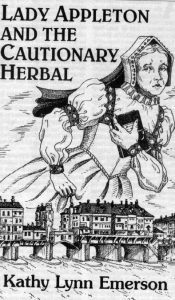 After that, I was invited to contribute to several other anthologies. I was pleased, of course, but I also knew that if I was invited, they would probably publish whatever I submitted. There was only one way to deal with doubts about my ability to write a short story—I had to have one accepted by either Alfred Hitchcock’s Mystery Magazine or Ellery Queen’s Mystery Magazine. I tried Alfred first and beginner’s luck was on my side. They accepted “Lady Appleton and the Cautionary Herbal” for their March 2001 issue. In 2004, a collection of my short stories about Lady Appleton and her friends, Murders and Other Confusions, was published by Crippen & Landru.
After that, I was invited to contribute to several other anthologies. I was pleased, of course, but I also knew that if I was invited, they would probably publish whatever I submitted. There was only one way to deal with doubts about my ability to write a short story—I had to have one accepted by either Alfred Hitchcock’s Mystery Magazine or Ellery Queen’s Mystery Magazine. I tried Alfred first and beginner’s luck was on my side. They accepted “Lady Appleton and the Cautionary Herbal” for their March 2001 issue. In 2004, a collection of my short stories about Lady Appleton and her friends, Murders and Other Confusions, was published by Crippen & Landru.
This year, I have two new short stories coming out. One with a modern setting, “The Boston Post Cane,” will appear in Level Best Books’ Best New England Crime Stories: Windward in November. “Lady Appleton and the Creature of the Night” in their December issue will mark my tenth appearance in Alfred Hitchcock’s Mystery Magazine.
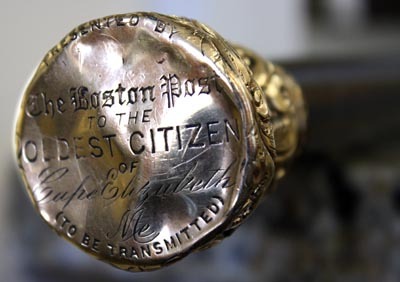
Does that look like a great murder weapon, or what?
Why, you may be wondering, did I decide to focus on short stories in this blog? It was partly because the topic fits in so well with a campaign called “We Love Short Stories” that was recently launched by Sisters in Crime. Its aim is to promote the genre and provide helpful information about writing and marketing mystery short stories. This is great for everyone and with luck will lead to more interest in publishing short fiction. 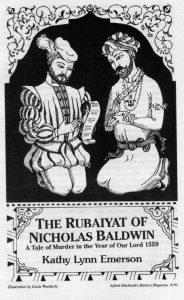 For more information: http://www.sistersincrime.org/page/ShortStories But I had another reason for picking this subject, too. Next spring, just in time for Malice Domestic, Wildside Press will be publishing Mystery Most Historical, the new Malice Domestic anthology. That in itself is pretty exciting. But wait . . . there’s more. At the same time, Wildside will also be bringing out my second collection of short stories. It is titled Different Times, Different Crimes and, as the title suggests, contains stories from different eras. Some, like my medieval “The Reiving of Bonville Keep,” are previously published tales, but others, like “Calendar Gal,” are brand new and set in the present day. In two of the stories, the sleuth is a professional photographer who first appeared, as a secondary character, in the ninth book in my Liss MacCrimmon series, The Scottie Barked at Midnight.
For more information: http://www.sistersincrime.org/page/ShortStories But I had another reason for picking this subject, too. Next spring, just in time for Malice Domestic, Wildside Press will be publishing Mystery Most Historical, the new Malice Domestic anthology. That in itself is pretty exciting. But wait . . . there’s more. At the same time, Wildside will also be bringing out my second collection of short stories. It is titled Different Times, Different Crimes and, as the title suggests, contains stories from different eras. Some, like my medieval “The Reiving of Bonville Keep,” are previously published tales, but others, like “Calendar Gal,” are brand new and set in the present day. In two of the stories, the sleuth is a professional photographer who first appeared, as a secondary character, in the ninth book in my Liss MacCrimmon series, The Scottie Barked at Midnight.
So, that’s all my short story news (for now!). How about you? Do you write short stories? Do you read them? I’d love it if you’d share your thoughts in the comments section below.

Kathy Lynn Emerson/Kaitlyn Dunnett is the author of over fifty books written under several names. She won the Agatha Award for best mystery nonfiction of 2008 for How to Write Killer Historical Mysteries and was an Agatha Award finalist in 2015 in the best mystery short story category for “The Blessing Witch.” Currently she writes the contemporary Liss MacCrimmon Mysteries (Kilt at the Highland Games) as Kaitlyn and the historical Mistress Jaffrey Mysteries (Murder in a Cornish Alehouse ~ UK in December 2016; US in April 2017) as Kathy. The latter series is a spin-off from her earlier “Face Down” series and is set in Elizabethan England. Her websites are www.KaitlynDunnett.com and www.KathyLynnEmerson.com
July 31, 2016
Some of my favorite things on the Blue Hill Peninsula
By Brenda Buchanan
My stop on the MCW summer tour is a place I used to live and where we still vacation – the beautiful Blue Hill Peninsula.

Sunset looking up the bay from Brooklin toward Blue Hill
If you aren’t quite sure where Blue Hill (no, not Mount Blue) is located, you aren’t alone. Mount Desert Island gets most of the Hancock County ink, for understandable reasons. That’s fine with those of us who enjoy spending a day or two in and around busy Acadia National Park, but prefer to spent our down time on the laid-back peninsula that lies to its west.
In addition to Blue Hill, the peninsula is made up of the towns of Brooklin, Brooksville, Sedgwick Penobscot, Surry, Orland and Castine. Deer Isle and Stonington lie across the high bridge that spans Eggemoggin Reach.
Remember this Dan Fogelberg song? https://www.youtube.com/watch?v=HEL_qqXGjHU It was written about this place.
The Blue Hill Peninsula is a mellow place, but there’s plenty to do.
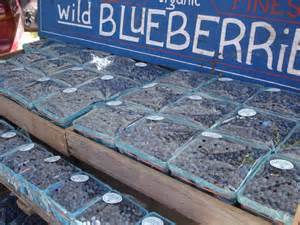
Blueberries grown by Ruth and Nick at their organic farm in Penobscot are sold at many local Farmer’s Markets in August
Every day there’s a farmer’s market in one town or another where you can buy not only tomatoes, greens, carrots and peppers, but pies and burritos, homemade vinegars and locally grown tea blends, smoked meat and fresh fish.
There are myriad places to hike, thanks in large part to the Blue Hill Heritage Trust, Island Heritage Trust, Maine Coast Heritage Trust and the Nature Conservancy, which own many spectacular properties and maintain a great trail network across the region.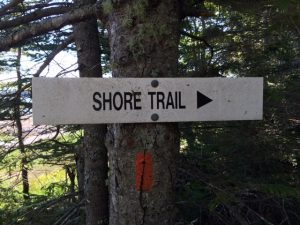
There are easy hikes and more challenging ones. All pass through beautiful land and provide context for the trust’s work to protect precious natural habitat and resources. Here’s a link to its website: http://bluehillheritagetrust.org/
We love swimming in cold ocean water, and seek out little pocket beaches because we like a little peace and quiet with our sun and sand.

A pristine beach, perfect for a swim on a hot summer day
Here’s a photo of one of our favorites. There’s no parking lot. No snack stand. But it offers crystal clear water and good bird watching. And no, I’m not going to divulge its exact location.
Many ponds also dot the peninsula, which offer swimming and boating opportunity for those who like their water a little warmer and prefer kayaking or fishing in freshwater.

View from atop Caterpillar Hill in Sedgwick, with the ocean on the left and Walker Pond on the right.
There’s music a-plenty on the Blue Hill Peninsula. We always get tickets for a concert at Kneisel Hall, a chamber music school and festival perched on the side of Blue Hill itself. Founded in 1902, it provides an opportunity to hear world-class musicians in an intimate setting. Click here for its website: http://kneisel.org/
In late July we took in the final concert of this year’s Blue Hill Bach concert, which was superb.Every July out-of-town and local musicians collaborate on an ambitious program that invariably brings the crowd to its feet.
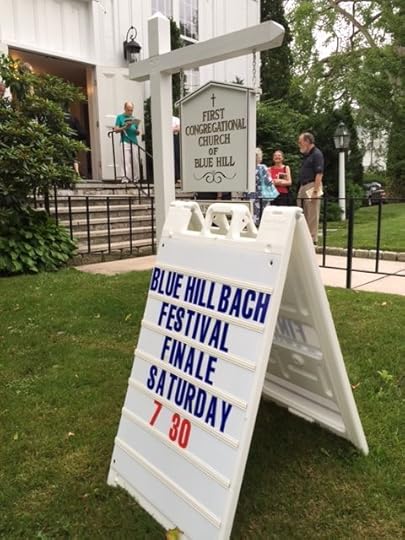
A great annual event
If classical isn’t your ticket, check out Flash! In The Pans. Every Monday night in the summer, Flash! brings the rhythm and lilt of steel drum music to the area, usually at the Blue Hill Town Park but sometimes in one of the surrounding towns. This award-winning band is made up of community members, young and old. Here’s a video from a few years ago when Flash! was on the road, playing in Southwest Harbor. https://vimeo.com/14456920
Evenings not spent at musical events frequently are spent at readings. The local libraries, often in conjunction with the fabulous Blue Hill Books and various community organizations regularly invite poets and writers of fiction and non-fiction to read and speak about their work.
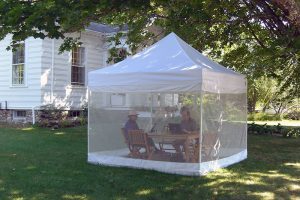
The summer annex at the wonderful Friend Memorial Library in Brooklin, a bug free shelter to check email when the library itself is closed.
Some big names read in the summertime—last year we heard Lily King and this year we expect to see Terry Tempest Williams. Needless to say, I was honored to have my name on the sign outside the Blue Hill Library last November when I did a reading from Cover Story.
Attuned to the fact that many rental cottages don’t offer internet access, the local libraries also provide picnic tables, porches and tents so those who can’t leave the office behind can check their email in between their morning kayak and their afternoon hike.
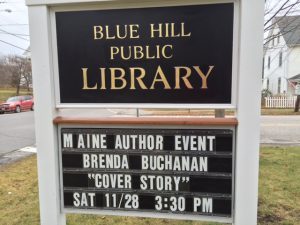
Last fall I was honored to have the opportunity to read at the wonderful Blue Hill Public Library
Many of the other summer tour of Maine posts on this blog have talked about the food and drink options that abound in our marvelous state. There’s plenty to eat and drink in the Blue Hill area as well.
Like Mexican? Head to El El Frijoles at Sargentville end of Caterpillar Hill Road. Never had a lobster burrito? You have no idea what you’re missing and trust me, you will thank me for this tip. Here’s a video where the owners talk about their wonderful, funky operation. https://vimeo.com/62826779
On Tuesday, Wednesday and Friday evenings, the wood-fired oven at Tinder Hearth Bakery in rural Brooksville is loaded up with delectable handmade pizzas. It is essential to call ahead and reserve one, as they fly out the door. Al fresco dining is available in the yard behind the bakery, or pies can be taken home. Tinder Hearth is wildly popular, as the line of cars on the side of the Coastal Road in this photo attests.

Get your amazing pizza here, by reservation only, three nights a week.
The most amazing lunches (lobster po’ boy, salads made with luscious local produce) can be had on the deck at Aragosta, which perches over Stonington Harbor. Fresh-made sandwiches, cookies and other beach picnic fixings are available at Buck’s Harbor Market in Brooksville.
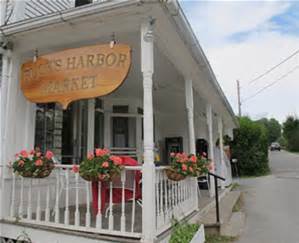
This the place to pick up all you’ll need for a picnic lunch
Other spots we love: The Farmhouse in Blue Hill (order a crab cake BLT or fish tacos and eat outside on the back lawn), Bagaduce Lunch at the Reversing Falls in Brooksville (the fish and chips and lobster rolls are divine), Strong Brewing Company in Sedgwick (the hoppy Localmotive is one of my faves) and Deep Water Brew Pub in Blue Hill (Three Sheets Porter, yum!), Buck’s Restaurant in Buck’s Harbor (house smoked salmon to die for), and when we want to dress up, Arborvine in Blue Hill (everything on the menu, essentially).
Many local non-profit organizations put on lobster bakes or chicken barbecues in the summer to raise funds for their community work.

August in Maine means lobster bakes
This offers an opportunity to buy a terrific dinner and support a good cause at the same time. It also allows you do sit elbow-to-wetnap with locals and other visitors, which can lead to the most interesting conversations.
Then there is the pie. Like the rest of Downeast Maine, the Blue Hill peninsula is blessed with blueberry fields in the summer and that means pie is abundant. Pie truly is the food of the gods. It’s my favorite dessert, too. (And breakfast, to be completely truthful.)
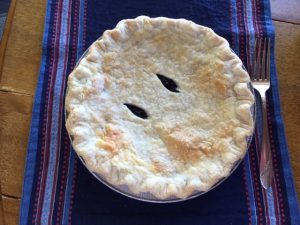
Maine wild blueberry pie
For those who enjoy their pie a la mode, The Ice Cream Lady, based in Brooklin, churns out some winning flavors that are available at many local markets. I have found the ginger, coconut and lemon pair especially well with blueberry pie.

A spectacular sunset on the Blue Hill Peninsula
July 30, 2016
Cape Elizabeth for the 99 Percenter . .
Whenever I travel around the state and tell people I live in Cape Elizabeth, the first thing they do is look at my shoes to see if I’m wearing Johnston and Murphy or my shirts to see if they’re from Mercer and Sons. Cape’s reputation as one of the wealthier communities in the state precedes it and I’m not sure people outside of southern Maine expect to see someone from the town dressed out of Reny’s via Marden’s. Of course the ocean side of town—Shore Road—is home to the big rockpiles and estates built by and for such luminaries as the architect John Calvin Stevens. But those of us who live in what’s affectionately known as Baja Cape (or NoSpur—North of Spurwink) know there are plenty of pleasures available to the day tripper and resident hoi polloi.
While not exactly prohibited from the private drives along Shore Road, visitors are more encouraged to visit the free and public park at Portland Head Light,  the iconic lighthouse depicted in advertisements for everything from Reny’s advertisements to cell phones.
the iconic lighthouse depicted in advertisements for everything from Reny’s advertisements to cell phones.
Fort Williams Park, which contains the lighthouse, also houses a gorgeous cliff walk, with views of the ocean and the cities of Portland and South Portland, as well as some of the best lobster rolls in town. Parking and entrance is free; lobster rolls are not.
Walk off your crustacean-induced coma a short jaunt south on Shore Road at the Cape Elizabeth Land Trust trails in Robinson Woods, with free parking available at the road side. Robinson Woods contains over 145 acres of land with walking trails, fields, ponds, and woods. Because the land was never suitable for farming, much of it is in the same state as it has been for centuries. Massive trees, streams, wildflowers, and ferns grace your path as you feel your cholesterol-fuelled pulse return to normal. The Land Trust has numerous other parcels in Cape Elizabeth also suitable for walking. See this list for details.
Moving farther south on Shore Road, be sure to take a long look at the view from Pond Cove on the left, another Land Trust parcel that hosted some of the earliest settlements in Cape Elizabeth.
Ready for a beach day instead? No problem. Continue up Shore Road to the intersection with Ocean House Road (Route 77) and take a left.
Cape Elizabeth has two state parks with excellent sand beaches. Kettle Cove and Crescent Beach are next to each other, just off Route 77 to the left about a mile or so beyond the “center” of town. Kettle Cove is the smaller of the two parks, with a small well-protected beach and walking trails. Take the left off 77 just before the Kettle Cove Creamery (ice cream later!)  and follow the road out to the parking lot. To reach Crescent Beach, which is larger and has shower, changing, and restroom facilities, continue down 77 to the sign. Both beaches are State Parks and have entry fees, though Kettle Cove’s fee is on the honor system—please pay it!
and follow the road out to the parking lot. To reach Crescent Beach, which is larger and has shower, changing, and restroom facilities, continue down 77 to the sign. Both beaches are State Parks and have entry fees, though Kettle Cove’s fee is on the honor system—please pay it!
Rainy day. Tour the local farmstands—Jordan’s Farm and Alewive’s Brook Farm (don’t mention my name to Jodie!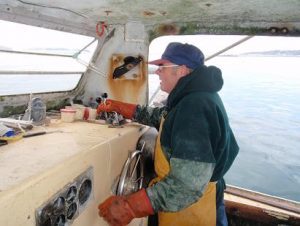 ) for almost anything in season and Maxwell’s Farm. Lunch at C Salt Gourmet Market (year-round) for good sandwiches or Two Lights Lobster Shack (seasonal) for the best fried clams in town.
) for almost anything in season and Maxwell’s Farm. Lunch at C Salt Gourmet Market (year-round) for good sandwiches or Two Lights Lobster Shack (seasonal) for the best fried clams in town.
Of course the best places in Maine are only known to the locals and Cape Elizabeth is no different. We have one of the best Transfer Stations (aka The Dump) around and a Swap Shop, where residents leave and retrieve all kinds of treasures, from furniture to paperbacks.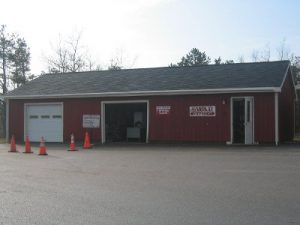
Many’s the good find come from the Cape Elizabeth Swap Shop
but you need to get there early on Saturdays—the ambience is reminiscent of Filene’s Basement on the pre-Christmas sales. You’ll have to find someone with a resident sticker to take you, though. In Cape Elizabeth, our junk is for us . . .
July 29, 2016
Weekend Update: July 30-31, 2016
 Next week at Maine Crime Writers there will be posts by Brenda Buchanan (Monday), Kaitlyn Dunnett/Kathy Lynn Emerson (Tuesday), Bruce Coffin (Wednesday), Maureen Milliken (Thursday), and Barb Ross (Friday). And in our special “A Day In . . . “ series, Dick Cass will post a blog tomorrow.
Next week at Maine Crime Writers there will be posts by Brenda Buchanan (Monday), Kaitlyn Dunnett/Kathy Lynn Emerson (Tuesday), Bruce Coffin (Wednesday), Maureen Milliken (Thursday), and Barb Ross (Friday). And in our special “A Day In . . . “ series, Dick Cass will post a blog tomorrow.
In the news department, here’s what’s happening with some of us who blog regularly at Maine Crime Writers:
Beyond the Sea Book Festival in Lincolnville Beach at Beyond the Sea (2526 Atlantic Highway, Lincolnville) is all all-day event today, July 30. There will be lots of Maine authors signing books there, including our own Dorothy Cannell, Kaitlyn Dunnett/Kathy Lynn Emerson, Kate Flora, Barb Ross, and Lea Wait, plus frequent contributor Katherine Hall Page. Dorothy and Katherine will be there starting at 10:30 and the rest will be joining them at 11:15. For more information and listings of all the Maine writers who will be there, go to Beyond the Sea Maine or call 207-789-5555.
An invitation to readers of this blog: Do you have news relating to Maine, Crime, or Writing? We’d love to hear from you. Just comment below to share.
And a reminder: If your library, school, or organization is looking for a speaker, we are often available to talk about the writing process, research, where we get our ideas, and other mysteries of the business. Contact Kate Flora: mailto: kateflora@gmail.com
Lea Wait's Blog
- Lea Wait's profile
- 509 followers




